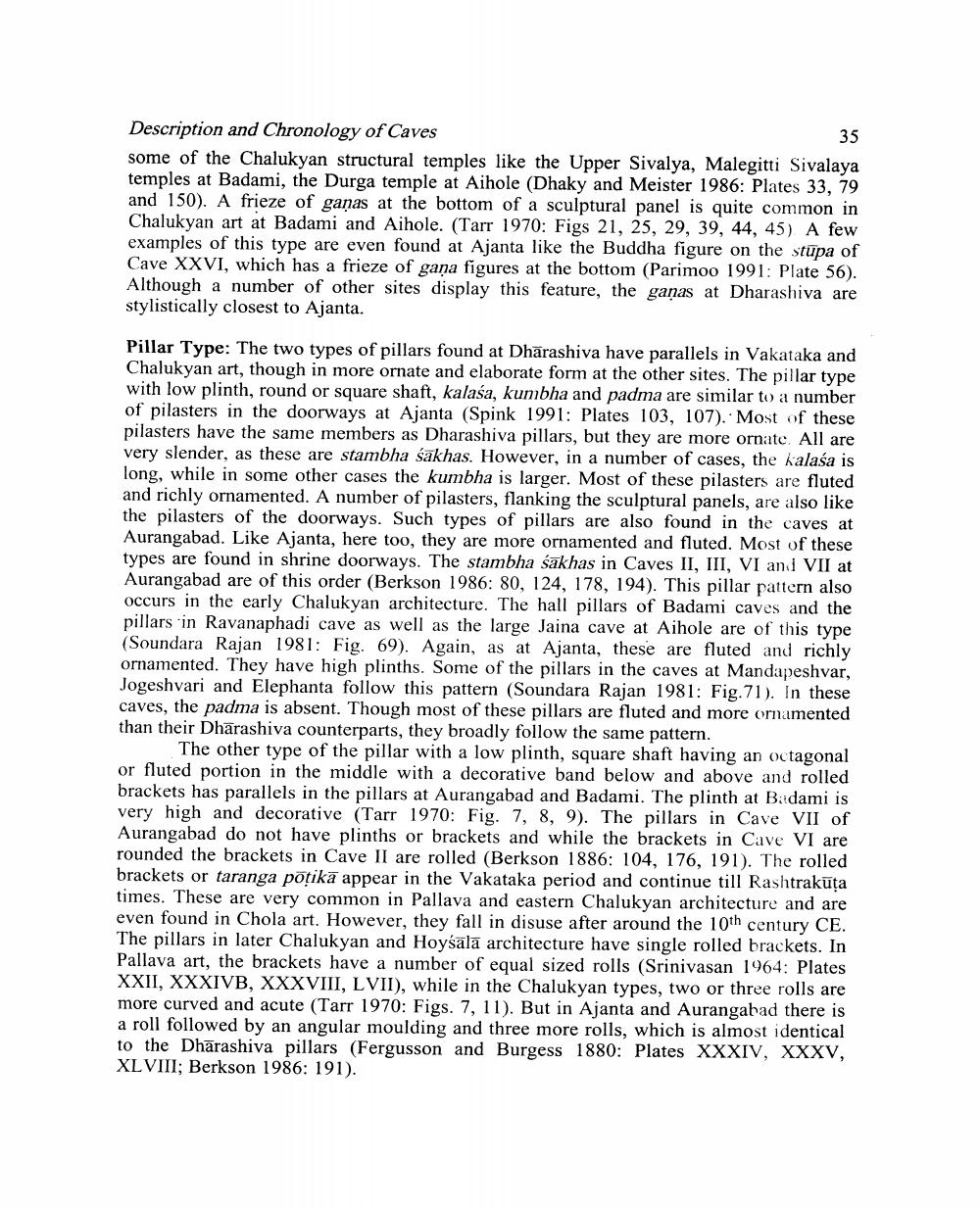________________
Description and Chronology of Caves
35
some of the Chalukyan structural temples like the Upper Sivalya, Malegitti Sivalaya temples at Badami, the Durga temple at Aihole (Dhaky and Meister 1986: Plates 33, 79 and 150). A frieze of ganas at the bottom of a sculptural panel is quite common in Chalukyan art at Badami and Aihole. (Tarr 1970: Figs 21, 25, 29, 39, 44, 45) A few examples of this type are even found at Ajanta like the Buddha figure on the stupa of Cave XXVI, which has a frieze of gana figures at the bottom (Parimoo 1991: Plate 56). Although a number of other sites display this feature, the ganas at Dharashiva are stylistically closest to Ajanta.
Pillar Type: The two types of pillars found at Dharashiva have parallels in Vakataka and Chalukyan art, though in more ornate and elaborate form at the other sites. The pillar type with low plinth, round or square shaft, kalaśa, kumbha and padma are similar to a number of pilasters in the doorways at Ajanta (Spink 1991: Plates 103, 107). Most of these pilasters have the same members as Dharashiva pillars, but they are more ornate. All are very slender, as these are stambha śakhas. However, in a number of cases, the kalasa is long, while in some other cases the kumbha is larger. Most of these pilasters are fluted and richly ornamented. A number of pilasters, flanking the sculptural panels, are also like the pilasters of the doorways. Such types of pillars are also found in the caves at Aurangabad. Like Ajanta, here too, they are more ornamented and fluted. Most of these types are found in shrine doorways. The stambha sakhas in Caves II, III, VI and VII at Aurangabad are of this order (Berkson 1986: 80, 124, 178, 194). This pillar pattern also occurs in the early Chalukyan architecture. The hall pillars of Badami caves and the pillars in Ravanaphadi cave as well as the large Jaina cave at Aihole are of this type (Soundara Rajan 1981: Fig. 69). Again, as at Ajanta, these are fluted and richly ornamented. They have high plinths. Some of the pillars in the caves at Mandapeshvar, Jogeshvari and Elephanta follow this pattern (Soundara Rajan 1981: Fig.71). In these caves, the padma is absent. Though most of these pillars are fluted and more ornamented than their Dharashiva counterparts, they broadly follow the same pattern.
The other type of the pillar with a low plinth, square shaft having an octagonal or fluted portion in the middle with a decorative band below and above and rolled brackets has parallels in the pillars at Aurangabad and Badami. The plinth at Badami is very high and decorative (Tarr 1970: Fig. 7, 8, 9). The pillars in Cave VII of Aurangabad do not have plinths or brackets and while the brackets in Cave VI are rounded the brackets in Cave II are rolled (Berkson 1886: 104, 176, 191). The rolled brackets or taranga pōtikā appear in the Vakataka period and continue till Rashtrakuta times. These are very common in Pallava and eastern Chalukyan architecture and are even found in Chola art. However, they fall in disuse after around the 10th century CE. The pillars in later Chalukyan and Hoysala architecture have single rolled brackets. In Pallava art, the brackets have a number of equal sized rolls (Srinivasan 1964: Plates XXII, XXXIVB, XXXVIII, LVII), while in the Chalukyan types, two or three rolls are more curved and acute (Tarr 1970: Figs. 7, 11). But in Ajanta and Aurangabad there is a roll followed by an angular moulding and three more rolls, which is almost identical to the Dhärashiva pillars (Fergusson and Burgess 1880: Plates XXXIV, XXXV, XLVIII; Berkson 1986: 191).




